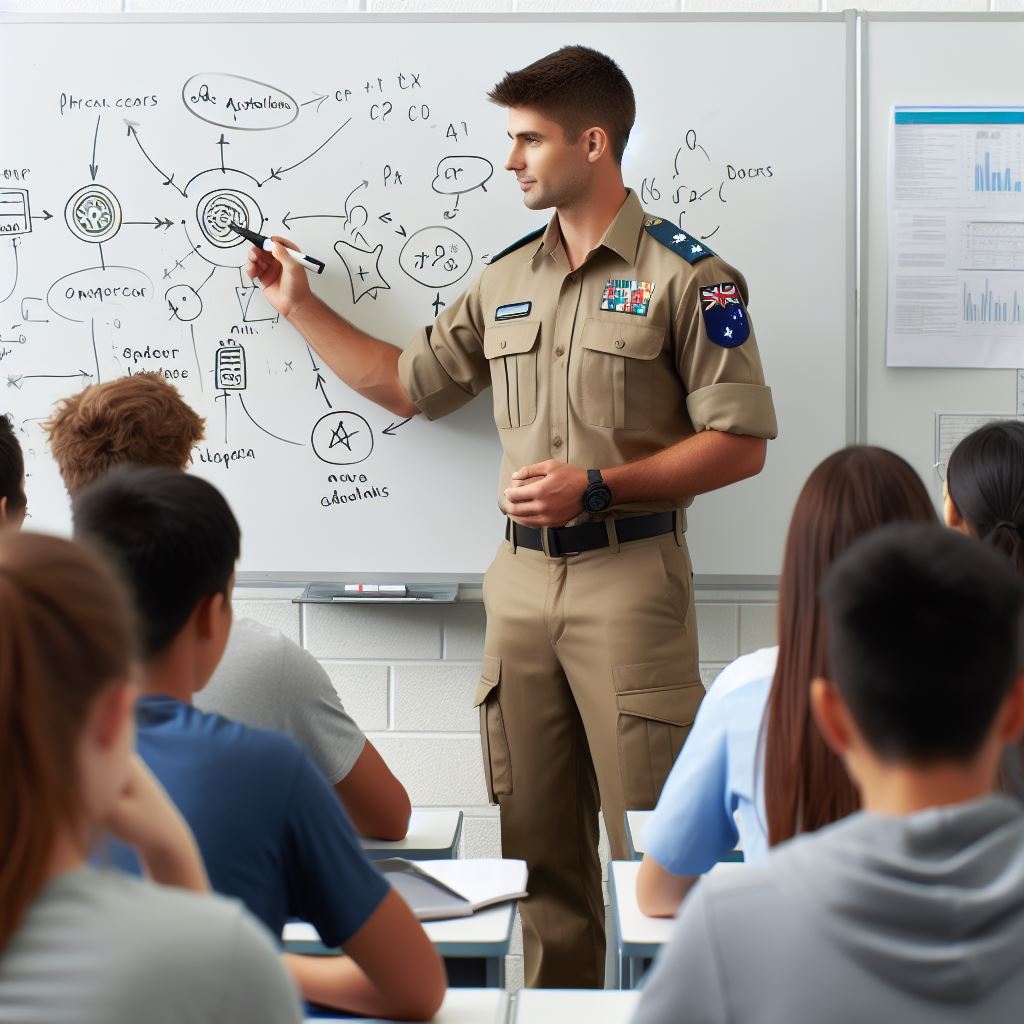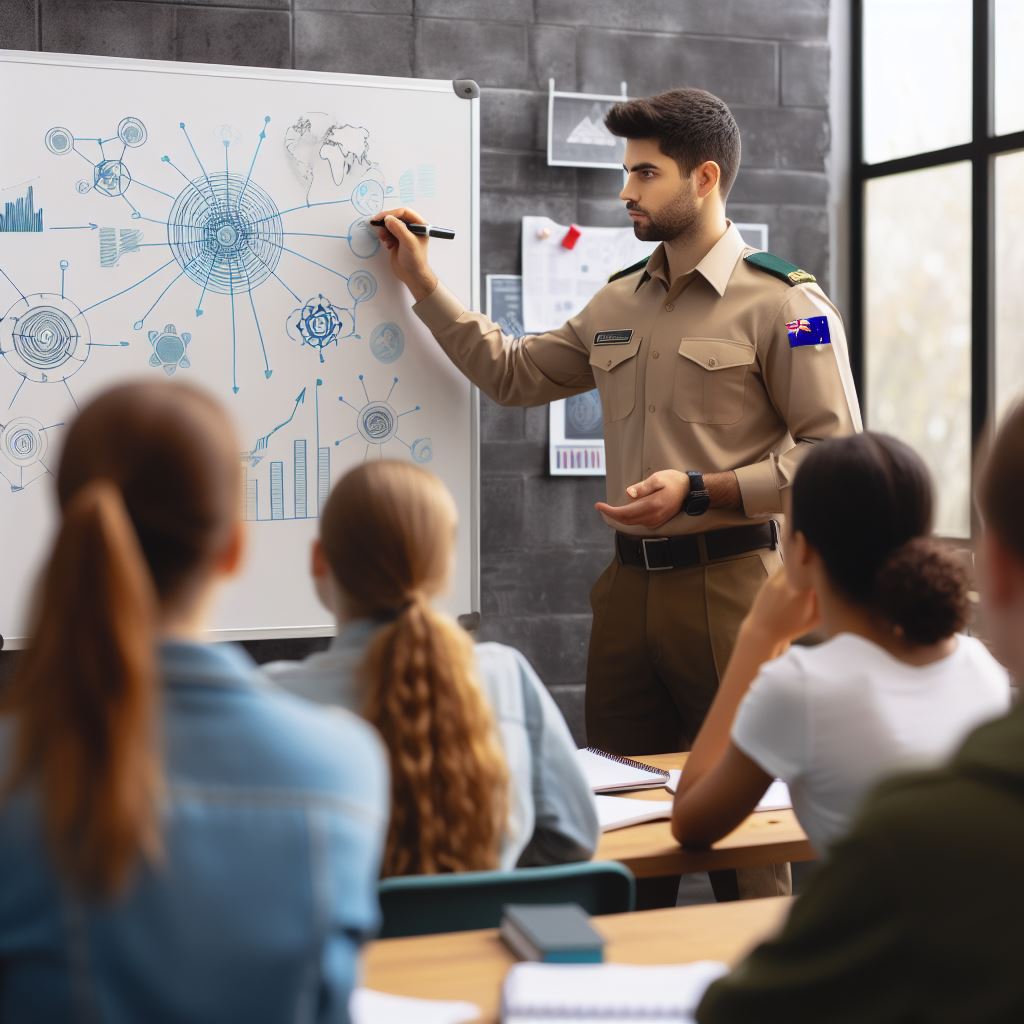Introduction
In the global landscape, the significance of education and training professionals reverberates as a cornerstone for societal progress and individual development.
As stewards of knowledge and architects of skill development, these professionals shape the intellectual landscape, fostering a future generation equipped with the tools to thrive in an ever-evolving world.
This blog post narrows its lens to focus on the Australian context, delving into the specific intricacies that define the educational landscape Down Under.
Education and training professionals play a pivotal role in sculpting minds and honing skills, fostering a society rich in knowledge and capabilities.
From primary educators shaping young minds to specialized trainers refining specific skill sets, these professionals form the bedrock upon which a nation’s intellectual capital is built.
Their impact resonates not only in individual lives but also in the broader societal and economic tapestry.
While the global perspective underscores the universal importance of education professionals, this blog post zeroes in on the unique dynamics within Australia.
The nuances of the Australian education system, coupled with its diverse cultural fabric, contribute to a distinct set of challenges and opportunities for those engaged in education and training roles.
Understanding these intricacies is imperative for professionals aspiring to excel in the Australian educational landscape.
Against this backdrop, the central focus of this blog post is to dissect and illuminate the top skills essential for education and training professionals in Australia.
By examining the specific competencies that empower professionals to navigate the Australian educational terrain effectively, we aim to provide valuable insights for both practitioners within the field and those aspiring to embark on a career dedicated to shaping the future through education.
Communication Skills
Importance of effective communication in the education and training industry
- Clear and effective communication is crucial for success in the education and training industry.
- Communication facilitates the exchange of knowledge, ideas, and information among educators, trainers, and learners.
- Effective communication ensures that learning objectives are clearly understood and achieved.
- It promotes student engagement, motivation, and a positive learning environment.
- Good communication also enhances relationships between training professionals, colleagues, and stakeholders.
Verbal and written communication skills
- Both verbal and written communication skills are essential for educational training professionals.
- Verbal communication involves expressing ideas, instructions, and feedback clearly and confidently.
- Training professionals should possess good public speaking skills and effective presentation abilities.
- Clear and concise written communication is necessary for creating training materials, reports, and correspondence.
- Writing skills include organizing information, using proper grammar and vocabulary, and adapting writing style for different purposes.
Active listening skills
- Active listening skills are crucial for educational training professionals.
- Active listening involves focusing on the speaker, understanding their message, and providing appropriate responses.
- Listening attentively helps trainers understand the needs, concerns, and questions of learners.
- It shows respect and empathy towards learners, which enhances the learning experience.
- Active listening allows trainers to gather feedback, adapt their teaching methods, and address any challenges or misconceptions.
Ability to adapt communication style for different audiences
- Educational training professionals should be able to adapt their communication style for different audiences.
- They need to consider the age, level of education, and cultural background of their learners.
- Adapting the communication style involves using appropriate language, tone, and nonverbal cues.
- Trainers must also be sensitive to individual learning styles and preferences.
- Adapting the communication style helps create a more inclusive and effective learning environment.
In a nutshell, strong communication skills are vital for educational training professionals in Australia.
Effective communication ensures successful knowledge exchange, promotes engagement, and enhances relationships.
Both verbal and written skills, active listening, and the ability to adapt communication style are essential for achieving positive learning outcomes and creating inclusive educational environments.
Read: Edu Consultant Qualifications Guide
Subject Matter Expertise
As an education training professional, having subject matter expertise is essential to effectively teach and train others.
It goes beyond just having a basic understanding of the subject – it requires a deep knowledge and understanding of the content being taught.
In-depth knowledge of the subject being taught or trained on
One of the primary responsibilities of an education training professional is to impart knowledge to learners. Therefore, having in-depth knowledge of the subject matter is crucial.
This means being well-versed in the theories, principles, and concepts that underpin the subject being taught.
Continuous learning and staying updated with the latest developments in the field
However, subject matter expertise is not static. It requires continuous learning and staying updated with the latest developments in the field.
In today’s rapidly changing world, new information and advancements constantly emerge, and it is essential for education training professionals to keep pace with these changes.
Ability to simplify complex concepts for learners
Moreover, the ability to simplify complex concepts for learners is another important aspect of subject matter expertise.
Many learners may struggle to grasp complex ideas, and it is the role of the education training professional to break down these concepts into simpler terms and explanations.
This requires a deep understanding of the subject matter and effective communication skills to convey the information clearly and concisely.
Incorporating real-world examples and practical applications
Furthermore, incorporating real-world examples and practical applications into the learning process is crucial for enhancing learners’ understanding and engagement.
Education training professionals should be able to connect the theoretical concepts with real-life scenarios, demonstrating how the knowledge being taught can be applied in practical situations.
This helps learners see the relevance and practicality of the subject matter, making it more meaningful and memorable for them.
In review, subject matter expertise is a key skill for education training professionals in Australia.
It involves having in-depth knowledge of the subject being taught, staying updated with the latest developments, simplifying complex concepts for learners, and incorporating real-world examples and practical applications.
By mastering this skill, education training professionals can effectively impart knowledge and facilitate meaningful learning experiences for their learners.
Read: Salary Insights for Edu Consultants
Instructional Design Skills
In order to be a successful education and training professional in Australia, it is essential to possess strong instructional design skills.
These skills involve designing engaging and effective learning experiences, understanding different learning styles, utilizing technology and multimedia tools, and assessing learning outcomes.
Designing engaging and effective learning experiences
- Create a clear and concise learning objective to guide the instructional design process.
- Develop content that is relevant, practical, and easily understandable for learners.
- Incorporate interactive and hands-on activities to enhance engagement and retention of information.
- Create opportunities for collaboration and peer-to-peer learning.
Understanding different learning styles and creating varied instructional methods
- Familiarize yourself with various learning styles, such as visual, auditory, and kinesthetic.
- Adapt your instructional design approach to cater to the diverse learning preferences of students.
- Use a combination of text, images, videos, and audio to cater to different learning styles.
- Provide options for learners to choose their preferred mode of learning when possible.
Utilizing technology and multimedia tools for interactive learning
- Stay updated with the latest educational technologies and multimedia tools available.
- Integrate technology into your instructional design process to enhance interactivity.
- Use multimedia tools like videos, podcasts, and interactive simulations to engage learners.
- Create online learning platforms or use learning management systems for remote education.
Assessing learning outcomes and making necessary adjustments
- Design formative and summative assessments to evaluate learning outcomes.
- Collect and analyze data to identify areas of improvement in the instructional design.
- Make necessary adjustments to the learning materials and activities based on assessment results.
- Seek feedback from learners to continuously improve the effectiveness of the learning experiences.
In summary, possessing strong instructional design skills is crucial for education and training professionals in Australia.
By designing engaging and effective learning experiences, understanding different learning styles, utilizing technology, and assessing learning outcomes, these professionals can ensure that learners receive high-quality education that meets their needs and maximizes their learning outcomes.
Read: Edu Consultants vs. School Counselors

Collaboration and Teamwork
Working collaboratively with colleagues to develop curriculum and training programs
- Engaging in regular meetings and brainstorming sessions to establish shared goals and objectives.
- Contributing ideas and insights to improve the effectiveness and relevance of the curriculum.
- Coordinating efforts to ensure seamless integration of different subjects and training materials.
- Utilizing technology tools and platforms for efficient collaboration and resource sharing.
- Actively listening to and considering diverse perspectives to foster creativity and innovation.
Building positive relationships with students, parents, and other stakeholders
- Establishing open lines of communication to address concerns and build trust.
- Engaging in regular parent-teacher meetings to provide progress updates and discuss individual needs.
- Seeking feedback from students to improve teaching methods and create a supportive learning environment.
- Collaborating with community organizations to enhance educational opportunities and resources.
- Showing empathy and understanding to create a welcoming and inclusive atmosphere for all stakeholders.
Participating in professional development opportunities and learning from peers
- Attending workshops, conferences, and seminars to stay updated with the latest educational trends.
- Engaging in online courses and webinars to enhance knowledge and acquire new teaching strategies.
- Joining professional networks and associations to exchange ideas and best practices.
- Sharing experiences and expertise with colleagues through collaborative projects and presentations.
- Reflecting on personal teaching practices and seeking feedback for continuous improvement.
Supporting a culture of collaboration and teamwork within the education and training institutions
- Encouraging and promoting interdisciplinary collaboration among educators to enrich students’ learning experiences.
- Facilitating team-building activities to foster positive relationships and effective communication.
- Creating shared spaces for teachers to collaborate and share resources.
- Recognizing and celebrating collaborative achievements to reinforce the value of teamwork.
- Instilling a sense of collective responsibility for the success and well-being of students.
Collaboration and teamwork are essential skills for education and training professionals in Australia.
By working collaboratively with colleagues, educators can develop cohesive and engaging curriculum and training programs.
Building positive relationships with students, parents, and other stakeholders creates a supportive learning environment.
Participating in professional development opportunities and learning from peers helps educators stay current and improve their teaching practices.
Supporting a culture of collaboration and teamwork within educational institutions enhances the overall quality of education and ensures the success of students.
Read: Choosing the Right Edu Consultant
Your Personalized Career Strategy
Unlock your potential with tailored career consulting. Get clear, actionable steps designed for your success. Start now!
Get StartedEmotional Intelligence
Recognizing and managing one’s emotions effectively
Being an education and training professional in Australia requires a high level of emotional intelligence.
This skill is crucial in recognizing and understanding our own emotions and being able to manage them effectively.
It is essential to be aware of how our emotions can impact our attitudes, behaviors, and interactions with students and colleagues.
Emotional intelligence allows us to stay calm and composed, even in challenging situations.
It helps us avoid impulsive reactions and respond thoughtfully instead.
By understanding our emotions, we can better control our stress levels and maintain a positive mindset.
Empathy and understanding students’ needs and concerns
Empathy is another vital skill for education and training professionals in Australia.
It involves acknowledging and understanding the emotions, perspectives, and needs of our students.
By putting ourselves in their shoes, we can create a supportive and inclusive learning environment.
Empathy enables us to connect with our students on a deeper level.
It allows us to show compassion and provide the necessary support they may require.
By recognizing their needs and concerns, we can tailor our teaching methods and approaches to meet their individual requirements.
Developing positive relationships with students and creating a supportive learning environment
One of the significant aspects of being an education and training professional is building positive relationships with students.
A supportive learning environment fosters trust, respect, and open communication.
By developing positive relationships, we create a safe space where students feel comfortable expressing themselves.
This environment encourages active participation, collaboration, and creativity.
It also enhances students’ motivation, engagement, and overall academic performance.
Handling conflicts or challenging situations in a constructive manner
Conflict and challenging situations are inevitable in any educational setting.
However, with emotional intelligence, we can address these situations constructively.
We must approach conflicts with patience, understanding, and fairness.
Active listening is a valuable technique in resolving conflicts.
It helps us understand different perspectives and find mutually beneficial solutions.
By encouraging open dialogue and collaborative problem-solving, we can turn conflicts into learning opportunities.
Moreover, emotional intelligence enables us to remain unbiased and objective while handling challenging situations.
Instead of reacting impulsively, we can respond sensitively and thoughtfully.
Emotional intelligence plays a crucial role in the success of education and training professionals in Australia.
By recognizing and managing our emotions effectively, demonstrating empathy, developing positive relationships, and handling conflicts constructively, we create a supportive learning environment for students.
These skills not only enhance students’ academic performance but also contribute to their personal and emotional growth.
As education and training professionals, it is our responsibility to cultivate emotional intelligence in ourselves and pass it on to our students, empowering them to thrive in their educational journeys.
Flexibility and Adaptability
Flexibility and adaptability are crucial skills for education and training professionals in Australia.
In today’s rapidly changing world, these skills enable trainers to keep up with the latest developments in education and deliver effective training to students.
Let’s delve into the importance of flexibility and adaptability in more detail.
Being open to change and embracing new teaching or training methodologies
Educational strategies and methodologies evolve constantly.
As an education and training professional, it is essential to stay up-to-date with the latest trends and research in the field.
Being open to change and embracing new teaching or training methodologies allows trainers to provide students with innovative and effective learning experiences.
By constantly exploring new approaches, trainers can discover alternative methods that may better suit their students’ needs.
They can experiment with different instructional techniques, such as problem-based learning or flipped classrooms, to enhance student engagement and promote active learning.
Embracing change also means staying open-minded and being willing to adapt teaching strategies based on individual student feedback.
Adapting to students’ individual learning needs and modifying instructional approaches
Every student has unique learning needs and preferences.
As educators, it is our responsibility to cater to these individual differences to ensure inclusive and personalized learning experiences.
Flexibility and adaptability come into play when modifying instructional approaches to meet students’ diverse learning styles.
Some students may learn best through visual aids, while others may prefer hands-on activities.
By being flexible in our instructional methods, we can tailor our teaching to meet these varied preferences.
This may involve incorporating multimedia resources, encouraging group collaborations, or providing extra guidance for students who require additional support.
Flexibility in scheduling and adjusting to different educational settings or environments
Education and training professionals often work in diverse settings, including schools, vocational training centers, or online platforms.
Flexibility in scheduling and adjusting to different environments is key to successfully navigate varied teaching contexts.
Trainers must be able to adapt their teaching methods based on the specific needs and resources available in different educational settings.
They may need to adjust their lesson plans, teaching materials, or delivery techniques to ensure maximum effectiveness in each context.
This flexibility allows trainers to provide a consistent and quality learning experience regardless of the environment.
Being receptive to feedback and continuously improving teaching or training methods
Feedback is invaluable for professional growth.
Education and training professionals should actively seek feedback from students, peers, and supervisors to evaluate the effectiveness of their teaching methods.
By being receptive to feedback, trainers can identify areas for improvement and make necessary adjustments to enhance their instructional approaches.
Continuous improvement is essential to provide the best possible learning experiences for students.
Trainers can attend professional development workshops, engage in peer collaborations, and stay updated with research to refine their skills and stay current with best practices.
Being open to critique and embracing opportunities for growth are integral parts of being a flexible and adaptable education and training professional.
In fact, flexibility and adaptability are vital skills for education and training professionals in Australia.
By being open to change, adapting to students’ individual learning needs, being flexible in different educational settings, and continuously improving teaching methods based on feedback, trainers can deliver high-quality education that meets the ever-evolving needs of students.
These skills contribute to creating engaging and effective learning experiences that foster student success.
Conclusion
In the dynamic realm of education and training in Australia, this exploration has illuminated the paramount skills that stand as pillars for professionals in this ever-evolving landscape.
Throughout our journey, we’ve discerned that effective communication, adaptability, technological proficiency, and a profound understanding of pedagogical methodologies are indispensable for education and training professionals.
These skills not only enable them to navigate the complexities of their roles but also empower them to deliver impactful learning experiences.
As we conclude, it is imperative to underscore the enduring relevance of these skills in the face of a rapidly evolving education landscape.
The digital age has ushered in transformative changes, demanding educators and trainers to adeptly incorporate technology, adapt teaching methodologies, and foster seamless communication.
The skills highlighted remain not just relevant but are increasingly vital as the education sector continues to witness paradigm shifts.
In this ever-changing landscape, our parting advice echoes the essence of continuous professional development.
Professionals in education and training are encouraged to embrace a mindset of lifelong learning, continuously honing their skills to stay at the forefront of educational innovation.
By investing in their skillsets, they not only future-proof their careers but also contribute to the advancement and resilience of the education sector.
As we bid farewell to this exploration, let it serve as a catalyst for professionals, inspiring them to embark on a journey of perpetual growth and development.
The skills encapsulated herein are not just tools for success but foundations upon which educators and trainers can build transformative careers in the dynamic tapestry of Australian education.




